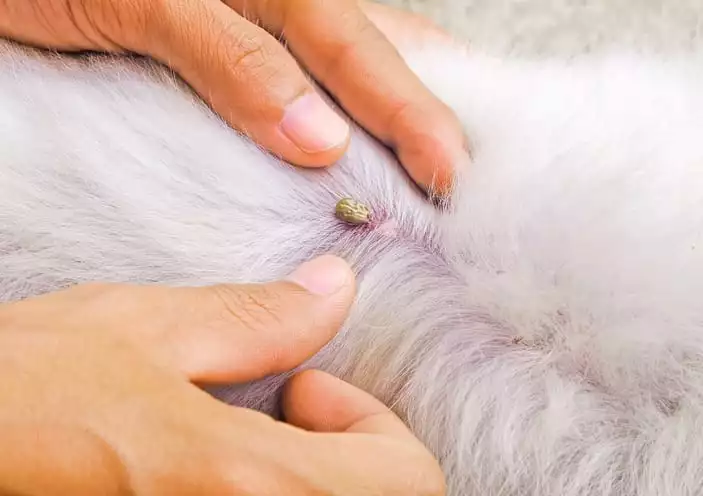Fleas and ticks are a problem for pet parents across the United States. A flea is a small, bloodsucking parasite that lives on the exterior of a host. Fleas can make our pets and us incredibly itchy, as well as making our pets anemic (low red blood cells). Ticks are also bloodsucking parasites that transmit serious diseases such as Lyme’s disease and Rocky Mountain Spotted Fever, both to our pets and humans. Because Springfield, Missouri is in the central part of the country, fleas and ticks are very common. The climate promotes the growth of tall grasses and heavily wooded areas in which fleas and ticks thrive.
When to Watch Out for Fleas and Ticks in Springfield
The worst time for fleas and ticks is in the summer months when our pets and wildlife are most active outside. However, you should be checking your pet during other parts of the year, too. While these pests thrive in the summer, they are still common year-round.
Fleas and Ticks Love Tall Grass, Moisture and Warmth
Fleas and ticks love moist, warm, shaded areas, all of which promote fast breeding. Dogs and cats that go into wooded areas after rainfall are especially in need of a full body search after they come home. Rainfall attracts fleas and ticks due to the moisture, especially in wooded areas and open spaces with tall grass. Fleas and ticks that are in the area quickly see the opportunity for a passing host to cling to or jump onto.
For those of you with outdoor areas, you should keep your grass short and manicured during the warmer months. Usually, ticks come out in late March to early October, so by maintaining a shorter lawn, you’re preventing these pests the opportunity to thrive. It’s best, especially in this area, to mow weekly so the grass doesn’t become a cool, shady place where wildlife is attracted to and where pests persist.
Get Flea and Tick Prevention
The most important piece of prevention is…to talk to your vet about preventive medications! It could be a flea and tick collar, a medication taken orally, or a topical treatment. By using a medicated preventive, you’re greatly reducing the chances that your pet will get either fleas or ticks.
Don’t Use Expired Flea and Tick Medication
Make sure you check the date on your products if they’ve been sitting in the cabinet a while. Expired medications aren’t nearly as potent and they lose effectiveness. When giving medication, it’s also critical to pay attention to what type of animal it’s for. Some medications for dogs are actually toxic to cats. Check with your vet if you have both types of pets in your house so that you don’t accidentally harm one of them.

How to Check Your Pets for Fleas and Ticks
If your cat or dog is outside often, as many are in the Springfield, MO area, you’ll want to check your pets often for fleas and ticks. When your pet returns from his outdoor adventures, give him a quick brush and check around for bugs, especially on the face and the shoulders (leading part of the dog through the brush). Depending on what kind of coat your pet has, they could be easy or hard to spot so look closely. Light colors and short hair are the easiest to see, and dark, long coats are more difficult. Common places that ticks will lodge are the armpits and ears.
I Found a Tick on My Dog…How Do I Remove It?
Let’s say that you find a tick. What do you do next? You need to remove it from your pet making sure to get the head and body. Use fine-point tweezers and get as close to the skin as you can. Then clamp onto the tick and slowly pull straight upward as steadily as you can. This helps keep the head attached to the body. If you have reason to believe the head is still lodged in your dog or cat’s skin, call your vet and ask for assistance. Make sure you obtain tick prevention as soon as possible because where there is one tick there are probably many more, even if you do not see them, be aware because and they can migrate from your pet to you! Many monthly medicated preventions prevent the transmission of dangerous tick diseases, even if they are applied as soon as you start seeing ticks on your dog!
Getting Rid of Fleas
Getting rid of fleas is a little more complicated. It usually takes 3 or 4 months to completely get rid of a flea infestation, so preventive medicine is critical to stop an infestation before it starts.
If you have an infestation, follow these helpful pointers. First, call your veterinarian for prevention. Preventions are guaranteed to work when you purchase products through your veterinarian and can start killing fleas and ticks immediately!
Second, you will need to wash all of your and your dog’s bedding in hot soapy water and preferably with bleach, vacuum all of the floors in your house including along the edges where the wall meets the floor, and then dump the contents out in a trash can at the side of the road so the fleas don’t find their way back into your home.
Lastly, contact a pest control company to treat your yard. The cost for monthly prevention is certainly less expensive than the cost of eliminating an infestation and the risk of health problems to your pet and unsightly and uncomfortable flea bites on your ankles!
You Can Prevent Your Pets from Getting Fleas and Ticks in Springfield
Preventing fleas and ticks for your pets in the Springfield, MO area is a fairly simple process; maintain a manicured lawn, check your pets when they come in from outside, regularly groom them, and put them on a preventive medication. The reality is that this environment is one where fleas and ticks thrive, so you need to stay diligent. With a few simple steps you will be able to keep your pet and you safe and healthy! For assistance with flea and tick medication, treatment, and prevention, contact us at Spring Valley Veterinary Hospitals.
For assistance with flea and tick medication, treatment, and prevention, contact us at Spring Valley Veterinary Hospitals.


